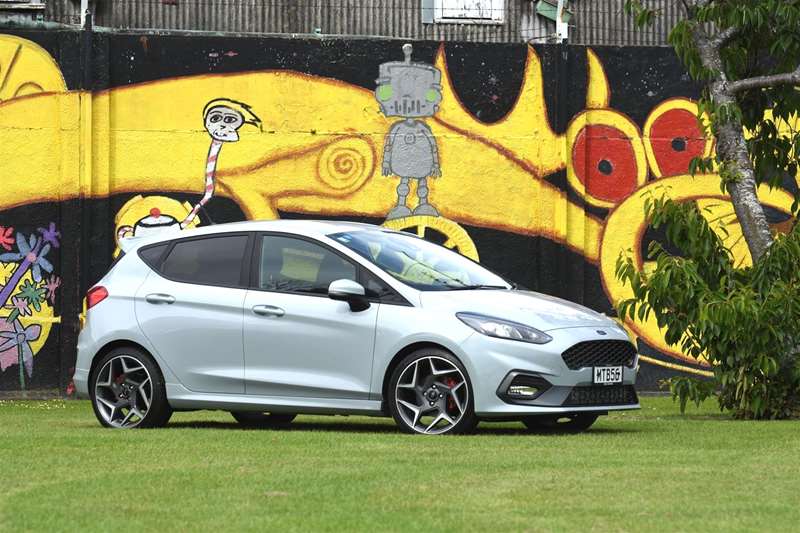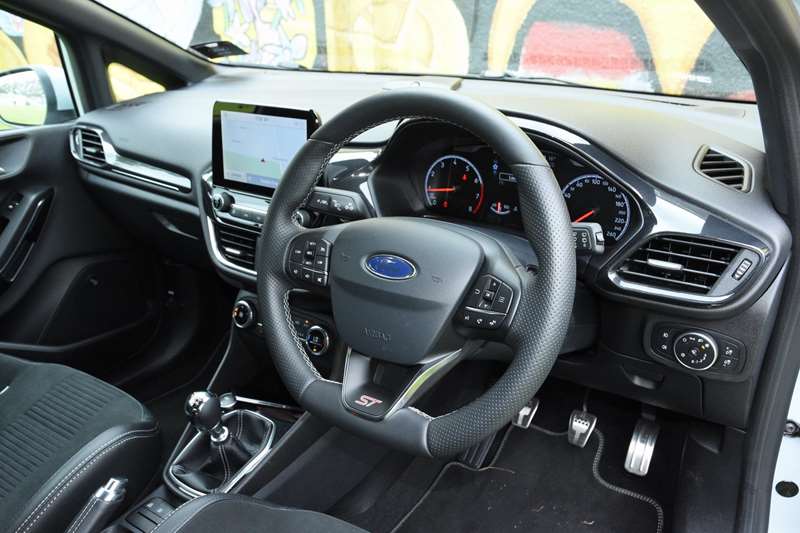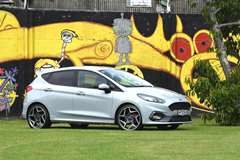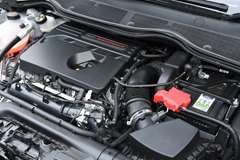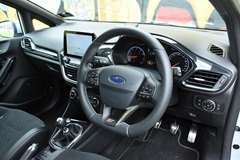With Kiwi motoring tastes now dominated by SUVs, Ford has elected to offer just one variant of the new Fiesta hatchback here — David Thomson tries it.
What’s new?
For much of the world, the current seventh-generation Ford Fiesta line up delivers extensive small hatchback choice: three- and five-door models, a range of petrol and petrol-electric hybrid powerplants, and in some countries half-a-dozen different equipment specifications too.
Selling in a market that has turned its back on conventional cars in recent years, Ford New Zealand has kept things far simpler with the new Fiesta: just one variant and that only available with that rarest of modern new-car items, a manual transmission.
This isn’t some toe-in-the water exercise to keep Ford NZ in the small car game with an entry-level model; the manual gearbox is there because the variant we see is the ST, the global performance flagship of the entire Fiesta range.
We had the previous ST here from late-2013 as part of a wider sixth-generation Fiesta line-up. Renowned for its fine handling, that ST was a three-door machine, powered by a 134kW/ 240Nm four-cylinder turbo 1.6-litre engine. Like its replacement, it was a manual-only model too, but much else has changed.
For starters, as a member of the seventh-generation Fiesta family, the latest ST is built on a new underlying platform. As well as being a little longer in the wheelbase, it gets a substantial stretch in wheel track. The suspension and damping is fundamentally revised too, it runs ultra-grippy Michelin sports tyres, and there is a new and more direct steering system.
There’s also a big change under the bonnet, with the old 134kW/240Nm four-pot 1.6 motor replaced by three-pot 1.5. Also turbocharged, this new engine musters superior peak outputs of 147kW and 290Nm. As before, a six-speed manual transmission delivers power to the front wheels, but this time it is supported by alimited slip differential. Launch control and a dedicated track mode are provided, as well as the usual normal and sport settings.
While the mechanical focus remains firmly on performance, there are various fuel-saving features too, including an automated system that seamlessly deactivates one of the car’s three cylinders when full power is not required. This helps the new Fiesta ST to achieve virtually the same standard cycle economy figure as its predecessor, at 6.3l/100km.
A big step-up in safety specification is provided as well.
Pricing has crept up to $39,990, which allows the Fiesta to stay a contender for the best sub-$40K performance car presently available in New Zealand.
What comes as standard?
The new ST’s active safety specification includes autonomous emergency braking (with pedestrian and cyclist detection), speed sign recognition, lane keeping assist, blind sport monitoring and rear cross traffic alert. Auto-dipping LED headlights are standard.
Creature comfort and convenience features include keyless entry and push-button start, single-zone climate control air-conditioning, heated front seats and a heated steering wheel, cruise control, satellite navigation, and a 10-speaker Bang & Olufsen sound system. Using Ford’s latest SNYC3 interface, the dash-mounted 8-inch centre touchscreen is home-base for an ICT set-up that includes smartphone mirroring and voice control as well as Bluetooth and dual-USB connectivity.
What’s it like to look at?
Visual links between the previous and new ST abound, but with its extra size and wider footprint, plus 18 rather than 17-inch alloys, the latest machine has a much more planted look on the road.
A wider black radiator grille and prominent front air dam contribute to a more aggressive look from the front. Red brake calipers peeping out from inside the wheels, subtle side skirts, twin exhausts, adiscreet rear wing and a rear diffuser add sporting vim to the gen-seven Fiesta look.
What’s it like inside?
Up front there are heavily bolstered Recaro sports seats, a sports steering wheel, that old-school manual gear lever, and a trio of alloy pedals. The Fiesta is certainly a compact hot hatch, but there is still space for a small centre storage bin between the front seats. Key controls are laid out in a logical manner, with the centre touchscreen freestanding on the dash, and the main instrument cluster compromising a small digital display screen flanked by an analogue rev counter and speedometer.=
The cabin trim is dark both above and below the windows, with a preponderance of hard touch surfaces. Chrome highlighting, gloss inserts and subtle contrast stitching give the trims a visual lift, and ST and Ford Performance badging is splashed about too.
The move to 5-doors makes this ST a more practical proposition for carrying passengers, and rear room is sufficient to accommodate a couple of adults in reasonable comfort. Boot space is a decent 311 litres (up from276 litres on the previous model), and the rear seats fold forward to boost it to almost 1100-litres. The extended boot floor isn’t flat though, and there is none of the interior packaging cleverness you’ll find in the likes of a Honda Jazz.
What’s it like to drive?
First impressions from behind the wheel are of a lower and sportier driving position than in the previous ST. The Recaro sports seats are snug, instrumentation is clear, and key controls fall nicely to hand.
Unsurprisingly, quite firm ride is a feature of everyday round town driving, but not to the extent ofits predecessor, and the new Fiesta ST in all other respects is a straightforward urban steer. Road noise is the major negative when cruising, and the provision of standard rather than full radar cruise control is a bit of a niggle too.
As a serious hot hatch, the Fiesta ST is designed to deliver at its best away from city limits and major highways, and in this respect Ford of Europe has gone the extra mile with a development programme that included fine-tuning its dynamic enhancements with significant time on the legendary Nurburgring racing track.
Mechanically it’s very strong, mustering maximum torque from just 1600rpm. It will rev out a little beyond its indicated 6250rpm red line too, though the engine’s sweet spot ends at around 5500rpm.
The special launch mode makes for easy ‘‘racing’’ starts, but those well-used to a decent manual gearbox will find making a slick getaway is equally feasible without electronic assistance.
Flicking through the gears, the Fiesta ST feels quicker than Ford’s official 0-100kmh time of 6.5 secs would suggest; that’s because with six close ratios, it’s necessary to slip into third gear to reach the legal limit. In-gear acceleration is both strong and linear.
Ultimately, though, the most memorable aspect of the Fiesta ST is the manner with which it negotiates the twists and turns of a decently demanding back road.
In terms of sheer tactile experience, it is by some margin, the best hot hatch I have driven in years: part of the fun comes in the rare joy of manual gear changes, but its steering is also wonderfully direct, the brake pedal full of feel, and in sport and track modes, there’s little sense of electronic driver aids intervening to dull the fun. Lateral grip is excellent and, aided considerably by its limited slip differential, Fiesta is remarkable by front-drive standards for the extent to which it can be balanced on the throttle through demanding bends.
Agility in terms of razor-sharp turn in and the capability to change direction quickly is impressive too, which speaks volumes of the fine-tuning carried out on the suspension, springs and damping systems, particularly given that Fiesta ST is constrained at the rear end by the inherent limitations of a torsion-beam rather than fully independent rear suspension set-up.
Last and not least given the current state of Otago roads, while ride can become brittle when mid-corner humps and bumps are encountered at speed, the test car proved remarkably resistant to being thrown offline by such imperfections.
Verdict
The previous Fiesta ST was a fine driver’s car, but the latest iteration raises the bar in all respects. Roomier and more practical as well as being even more fun to drive, it sets the benchmark for sub-$40K new car performance fun.
Photos: David Thomson
